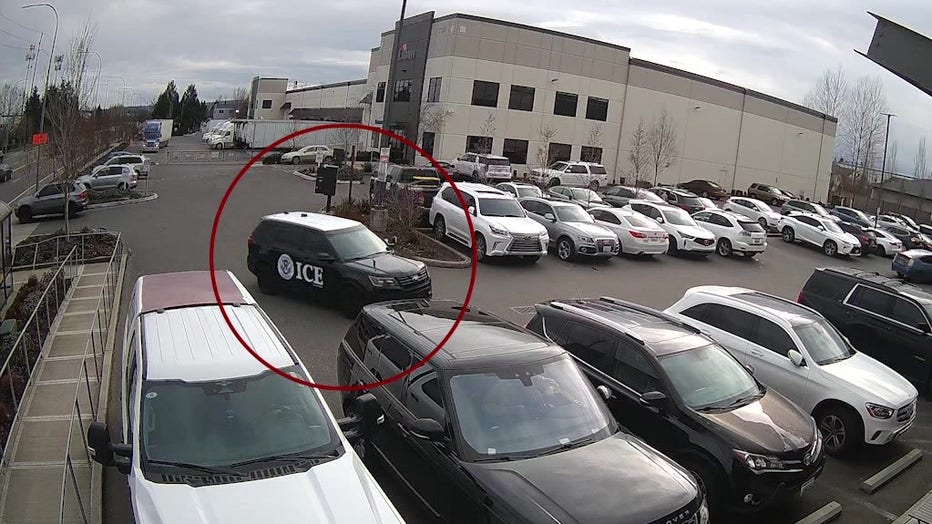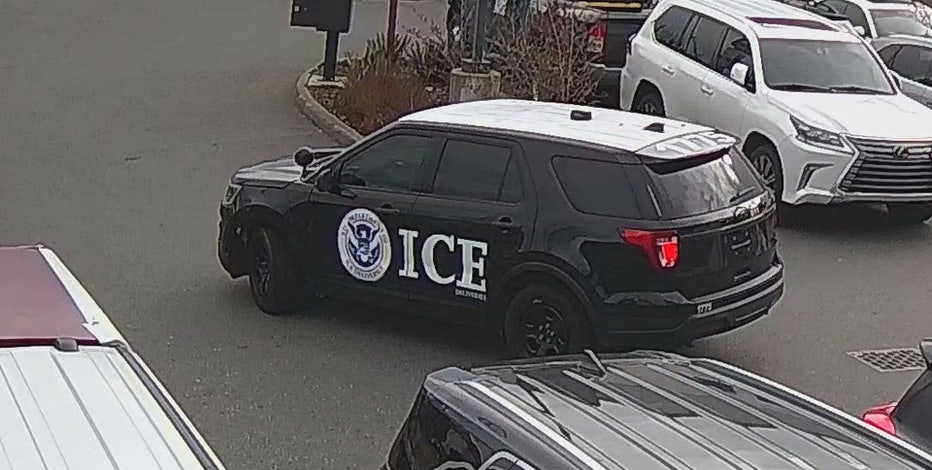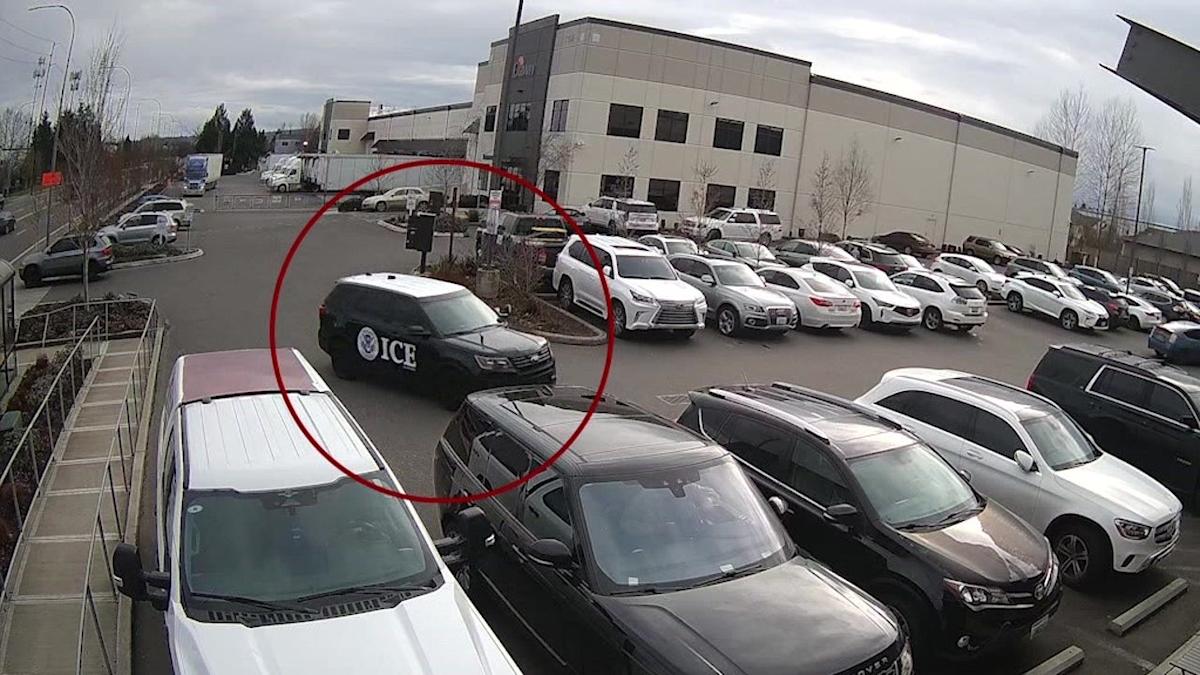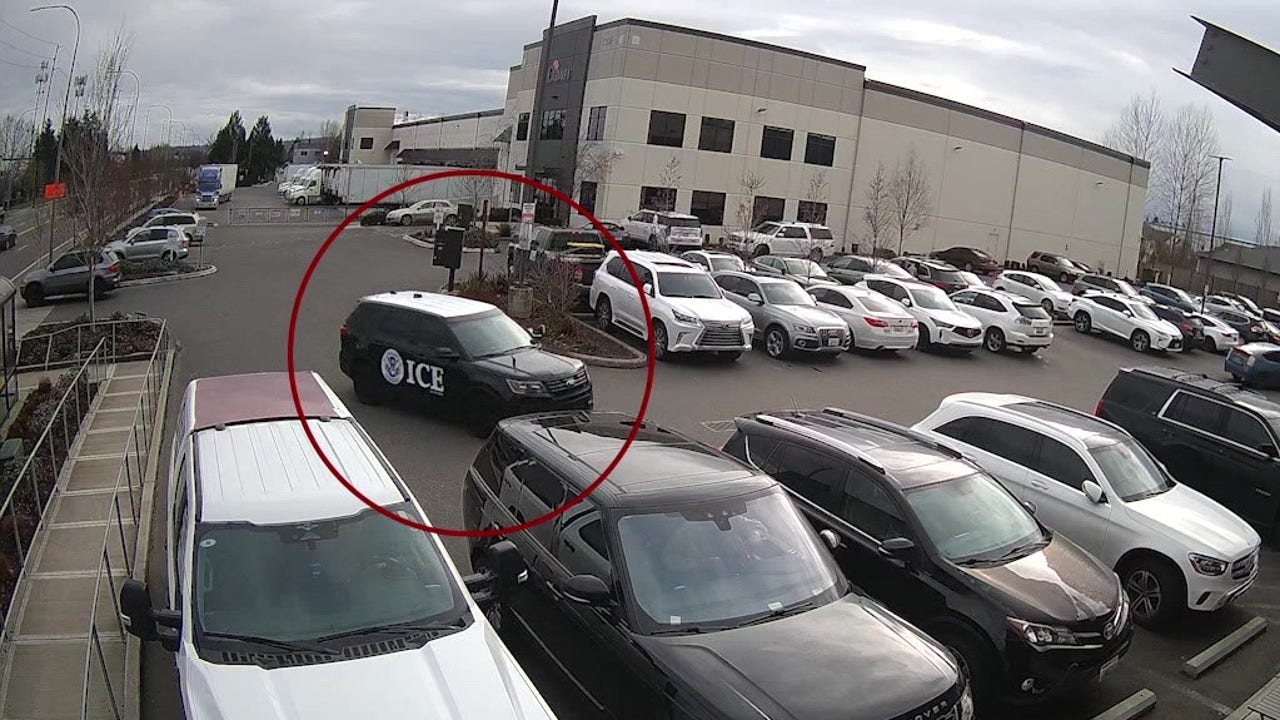Mysterious ‘ICE’ Vehicle in Fife Sparks Controversy, But What’s Behind the Ruse? In the quiet streets of Fife, Washington, a bizarre incident has caught the attention of authorities and social media enthusiasts alike. A vehicle allegedly painted to resemble an Immigration and Customs Enforcement (ICE) van has been spotted in the area, leaving many to wonder if this was a publicity stunt or something more sinister. The story took a surprising turn when local news outlet FOX 13 Seattle reported that the fake ‘ICE’ vehicle was actually a prop for a YouTube video. But what drove the creators to go to such extremes, and what can we learn from this intriguing incident?
Incident Overview
Background of the Fake ICE Vehicle Incident

In a recent incident in Fife, Washington, a vehicle displaying fake “ICE” decals caused a stir among the local community. Gizmoposts24 has uncovered the details of the incident, which involved a retired police SUV that was repurposed for a YouTube video. The vehicle, originally a patrol car for the Tukwila Police Department, was sold to a private individual, identified as Ilya Kukhar, after it was declared surplus by the insurance company.

Details of the Staged Arrest and Investigation
According to court documents provided by the Fife Police Department, the vehicle was used in a staged arrest scenario, which included a person in law enforcement-style clothing placing a handcuffed individual into the vehicle. The staged arrest was captured on video and was part of a YouTube video production. The footage was later shared with the police, leading to an investigation into the authenticity and legality of the incident.
The vehicle was spotted at the Emish Market, a Ukrainian market in Fife, where it was seen recording employees and customers, and allegedly honking its horn in the parking lot. This sparked concern among the local community, leading to an inquiry. The Fife Police Department, upon receiving reports and the video clip, launched an investigation to determine the nature and intent of the vehicle’s presence and actions.

Response from the Suspect and Law Enforcement
Ilya Kukhar, a 26-year-old resident of the area, was identified as the owner of the vehicle and the subject of the investigation. Kukhar claimed that his actions were part of a social media stunt that had “got blown out of proportion like crazy,” as reported in court documents. Kukhar explained that he no longer owned the vehicle and that the staged arrest was part of a YouTube video shoot conducted on private property. However, his explanation did not prevent the escalation of the situation.
Law enforcement’s response was immediate and thorough. They sought to clarify the legality of Kukhar’s actions, particularly the use of a vehicle that appeared to be a government vehicle and the staging of an arrest. The Fife Police Department confirmed that the vehicle was not an official ICE vehicle and that Kukhar had no affiliation with any law enforcement body. They charged Kukhar with second-degree criminal impersonation, a serious offense that carries significant legal ramifications.
Implications and Analysis
Potential Consequences of the Incident for the Suspect and Community

For the suspect, Ilya Kukhar, the consequences are severe. The charge of second-degree criminal impersonation can lead to a felony conviction, which could result in significant penalties including substantial fines and jail time. The legal process will likely be lengthy and complex, involving extensive evidence scrutiny and potentially a trial. Kukhar’s attorney has entered a not guilty plea, indicating an intention to challenge the charges.
The community impact of this incident is also considerable. The appearance of an official ICE vehicle in a community that includes many immigrants and refugees can cause significant distress and fear. Such actions can erode public trust in law enforcement and government agencies. The Fife Police Department has reassured the community that the vehicle was a fake and that Kukhar had no authority. However, the incident has highlighted the need for clear guidelines and enforcement against such impersonations.
From a broader perspective, this case underscores the challenges of balancing freedom of expression, particularly on social media, with the potential for public harm. The use of vehicles that mimic official law enforcement and government vehicles can have serious implications. Legal experts and community leaders argue that such actions, even if intended as entertainment, can have severe repercussions on community trust and public safety.
Examination of the Motivations Behind the Fake ICE Vehicle Stunt
Understanding the Stunt’s Purpose

Gizmoposts24 explores the motivations behind the recent incident involving a fake ICE vehicle in Fife, Washington. According to new court documents, the alleged perpetrator, Ilya Kukhar, 26, stated that his actions were part of a social media stunt aimed at generating content for his YouTube channel. The vehicle in question, a retired Tukwila police SUV with fraudulent ICE decals, was allegedly intended to heighten the authenticity of a staged arrest video. This tactic is not uncommon in the world of YouTube, where creators often strive for a blend of realism and spectacle to attract viewers.
The Influence of YouTube on Social Media Content
YouTube has become a platform where the line between entertainment and reality can blur. Creators like Kukhar often use exaggerated scenarios to capture the audience’s interest. However, the authenticity of such stunts can raise significant legal and ethical questions. In this case, Kukhar’s attempt to create a video that mimicked an actual ICE vehicle and officers’ actions has led to serious legal repercussions, indicating a misunderstanding of the boundaries between entertainment and deception.
Impact on Public Perception of Law Enforcement and Social Media Stunts
Public Reaction and Media Coverage
The incident has sparked a significant debate on the impact of social media stunts on public perception of law enforcement. Gizmoposts24 received feedback from viewers and community members who expressed concern over the confusion and unease caused by the fake ICE vehicle. The public was left questioning how to distinguish between genuine law enforcement activities and the increasingly sophisticated stunts generated for social media content.
Trust in Law Enforcement
The trust in law enforcement is often tested when such stunts occur. In this instance, the presence of a vehicle mimicking that of the ICE could have led to suspicion and anxiety among the community, particularly in sensitive areas like the Ukrainian market. The incident serves as a reminder of the responsibilities that content creators have in their productions and the importance of distinguishing between entertainment and serious law enforcement activities.
Practical Aspects and Next Steps
Legal Proceedings and Potential Outcomes for the Suspect
Ilya Kukhar faces serious legal consequences for his actions. Charged with second-degree criminal impersonation, Kukhar’s case is under scrutiny by local law enforcement and the judicial system. The legal team representing Kukhar entered a not guilty plea on his behalf. The potential outcomes range from severe fines to imprisonment, depending on the evidence presented and the judge’s interpretation of the crime’s severity. Legal experts advise that such stunts, especially those that misrepresent law enforcement, can have dire legal consequences, emphasizing the importance of informed consent and clear delineation between entertainment and reality.
Community Reaction and Measures to Prevent Similar Incidents
The community’s response to the incident has been mixed, with many expressing frustration and fear over the potential confusion and threat to public safety. Local authorities and community leaders have called for increased measures to prevent such incidents in the future. These include stricter regulations on the use of law enforcement imagery by social media content creators and enhanced public awareness campaigns to educate the community on how to identify and report suspicious activities. Community meetings and forums are expected to address these concerns and develop a comprehensive strategy to prevent similar occurrences.
Role of Social Media Platforms in Regulating and Monitoring User-Generated Content
Social media platforms have a critical role in monitoring content that could mislead the public. Platforms like YouTube have community guidelines and terms of service that prohibit misleading and harmful content. However, the rapid evolution of content creation techniques often outpaces the platforms’ ability to regulate them. Gizmoposts24 sources indicate that YouTube is increasing its efforts to detect and remove content that violates these guidelines, though challenges remain in distinguishing between creative freedom and harmful misinformation. Experts recommend a collaborative approach, involving content creators, platforms, and law enforcement, to develop a balanced and effective regulatory framework.
Expert Analysis and Insights
Interview with Legal Expert on Social Media Stunts
Dr. Sarah Thompson, a legal expert specializing in digital media, provides insights into the legal implications of social media stunts. Dr. Thompson points out that the creation of fake law enforcement vehicles for social media content can lead to substantial legal repercussions, including civil and criminal liabilities. She emphasizes the importance of obtaining proper permissions and maintaining transparency to avoid legal entanglements and public distrust.
Interview with Community Leader on Community Safety Measures
Mayor John Adams of Fife, a community leader, discusses the measures the city is taking to enhance community safety and prevent future incidents. Mayor Adams highlights the importance of fostering a collaborative environment where community members, law enforcement, and social media platforms work together to ensure public safety. Key measures include educational campaigns, community watch programs, and partnerships with local law enforcement to identify and report suspicious activities.
Interview with Social Media Platform Representatives on Platform Policies
Representatives from YouTube discuss the platform’s policies and ongoing efforts to address misleading content. They explain that YouTube employs a combination of automated systems and human reviewers to identify and remove content that violates their policies. However, the representatives acknowledge the challenge of balancing content freedom with community safety, and they emphasize the platform’s commitment to continuous improvement and collaboration with content creators and law enforcement to refine their monitoring systems.
Real-World Applications and Examples
Comparative Analysis with Similar Incidents
Comparing the Fife incident with similar cases from other regions where social media stunts have led to public confusion and legal issues highlights the broader implications of such stunts. In California, a similar incident involved a fake police vehicle used in a YouTube video, resulting in public panic and legal charges against the creator. These incidents underscore the need for stricter guidelines and clearer communication from creators regarding the nature of their content.
Case Study: The Fife Fake ICE Vehicle Stunt
The specific case of the fake ICE vehicle in Fife provides a detailed look at how such stunts can escalate to legal issues. The incident involved not only the creation of a fake law enforcement vehicle but also the staging of an arrest. While Kukhar’s actions were aimed at creating engaging content, the resulting public reaction and legal consequences reveal the unforeseen impacts of such stunts. This case study serves as a critical example for content creators about the importance of ethical considerations in their productions.
Expert Analysis on the Incident
Legal and social experts analyze the Fife incident, highlighting the broader implications of the stunt on community trust and public safety. Experts note that such incidents can erode the trust between the public and law enforcement, leading to a broader societal impact that extends beyond the immediate legal consequences faced by the individual creator. They advise content creators to consider the social and legal ramifications of their content, emphasizing the need for transparency and respect for law enforcement symbols.
Community Engagement and Measures
Community engagement has been a key focus post-incident. Fife’s local government has organized public forums and workshops to discuss the incident and its implications. These forums aim to enhance public education and awareness, ensuring that residents understand the difference between social media stunts and genuine law enforcement activities. Community leaders are also working on establishing stricter guidelines for local content creators, emphasizing the need for responsible behavior and the respect for public safety.
Regulatory and Technological Innovations
Technological and regulatory innovations are being explored to address the challenges posed by such stunts. Social media platforms are investing in advanced AI technology to detect and flag suspicious content more efficiently. Additionally, new regulatory measures are being proposed at the local and state levels, aiming to establish clearer guidelines for content creators regarding the use of law enforcement insignia and the portrayal of law enforcement activities. These measures seek to balance the freedom of expression with the responsibility to maintain public safety and trust.
Future of Content Creation and Public Trust
As social media continues to evolve, the future of content creation is increasingly intertwined with legal and ethical considerations. The Fife incident underscores the need for a more robust framework for content creators to operate within. Moving forward, a combination of stricter guidelines, enhanced public education, and technological advancements in content monitoring will be essential in maintaining public trust and ensuring the safety of communities. The incident also prompts a broader discussion on the role of social media platforms in shaping public perception and the ethical responsibilities of content creators in the digital age.
Conclusion
Concluding the Controversy: What’s Behind the “Fake ‘ICE’ Vehicle” in Fife, WA?
In a recent incident, a vehicle with the markings of Interpol’s “ICE” unit was allegedly used to stage a YouTube video in Fife, WA, sparking a heated debate about the authenticity of the footage. The video, which claimed to show agents pursuing a suspected human smuggler, sparked outrage among those close to the issue. As we delve into the details of this controversy, it becomes clear that this incident highlights the complexities of international law enforcement and the blurred lines between reality and fabrication.
At its core, the “ICE” vehicle in question was a specially designed, high-tech van equipped with advanced surveillance equipment and communication systems. Its intended purpose appears to be for operational use, not for generating fake news or entertainment content. This raises questions about the ethics of using such vehicles for covert operations and the potential consequences of such activities. Furthermore, the video’s authenticity and production quality have sparked concerns among those in the public eye, with some questioning whether the footage was staged or fabricated to support a particular agenda.
The implications of this incident go beyond the realm of international law enforcement, as it challenges our understanding of the boundaries between reality and fiction in the digital age. As we navigate the complexities of social media and online content, it becomes increasingly clear that the truth can be distorted, manipulated, and even fabricated with ease. This raises important questions about the role of media and technology in shaping our perceptions of the world around us.
Ultimately, this incident serves as a reminder that the line between truth and fiction can be perilously thin, and that the consequences of our actions can have far-reaching and devastating effects. As we move forward, it is essential that we prioritize transparency, accountability, and ethical behavior in our digital interactions, lest we risk perpetuating the very problems we seek to address.






Add Comment